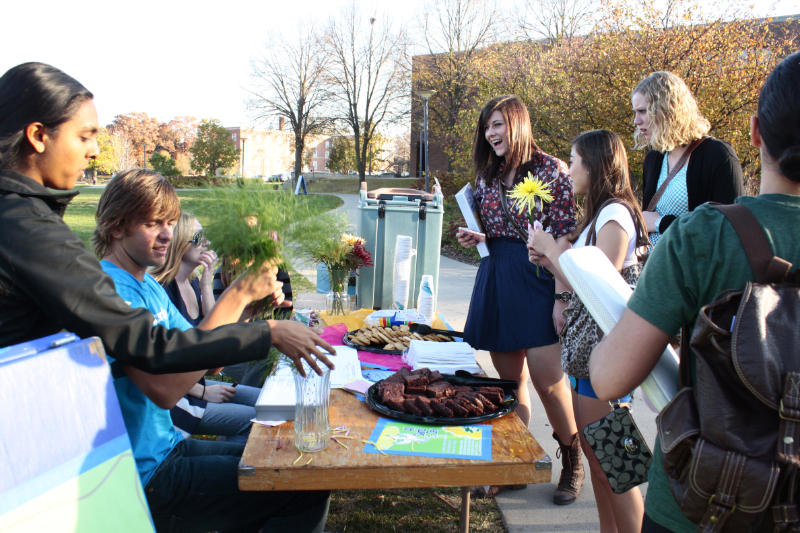Students discuss tensions on campus
*Editor’s note: This story was originally intended to be over a spectrum of multi-cultural organizations’ experiences with racism on campus. After hearing the stories of these students, we decided to focus on their experiences, because of the emotion and strength shown in them.
On a blustery day in April, members of the Coalition of Black Students met to hold its elections. The members of the organization gave thought-provoking, passionate speeches for why they should be elected into certain positions. After all the speeches were done, four students sat down to share their thoughts and experiences about racism on campus.
The students all had different stories, but they all had shared experiences.
Juniors Briana Isom-Brummer, Alexis Davis and Freddie Fulton all spoke about their experiences on campus since joining the student body three years ago.
From incidents at street painting to ones in the classroom, all three of them have dealt with situations involving racism.
Isom-Brummer is currently in an African-American literature class. She is one of two black students in the classroom. One frustration shared was “feeling obligated to speak” because she is one of the few African-Americans in the class.
“I don’t always want to feel obligated to talk just because I’m the black girl in the classroom,” Isom-Brummer said.
Being a theater major, Fulton has had troubles with representation. He said black culture isn’t discussed until students have to learn about “black face.”
Even with these experiences, he has some classes that encourage open dialogue. He is currently in “Black Christianity and Prophetic Politics,” a class taught by professor Jennifer Harvey. In this class, he is encouraged to have open and honest discussions.
“It opens my eyes, and it opens others’ eyes,” Fulton said.
Davis said that she appreciates interaction in the classroom more when they express how they feel instead of staying quiet.
“I’d rather you say it and understand why you feel that way,” she said. “When we have those conversations together, in the classroom especially, that makes an ultimate difference.”
She said there is a fakeness around Drake concerning issues of diversity. She wants conversations to start being “real.”
Issues within the classroom aren’t the only issues facing students of color. In March, students walking back from a theater production were yelled at from a Jewett Hall window. The yelling insinuated that those students walking on the painted street did not belong on campus. This incident was the crux of a petition circulated around campus and a flurry of discussions on how to change the climate of campus.
But that incident isn’t the first and only instance of racism on campus. The three students all said that there are little incidents that happen almost every day.
Whether it’s a lack of representation on campus or use of the word “nigger.” They’ve all had to deal with it.
“(The lack of representation of diversity) has made it clear to those that are diverse, and are from different backgrounds, that sometimes we have to show that we are welcome to be welcome,” Davis said.
Isom-Brummer had one incident last year during street painting.
“Everyone steals paint, that’s what everyone does,” she said. “But once we stole paint, it became a huge problem. We were called ‘bitch niggers’.”
She continued saying they were all just trying to have fun, and she just let the comment go.
Fulton said he has had apples thrown at him.
“It seems like everyone is doing just enough (concerning diversity),” Isom-Brummer said. She recently had a meeting where she discussed that students are more comfortable seeing more representations of themselves.
“One of the professors said ‘Oh, we do have a black teacher,’…You’re saying one is enough. He wasn’t trying to be racist, but he says that there was only one black professor — who doesn’t even identify as black — when there is [sic] how many white professors?” Isom-Brummer said.
The problems of racism transcend not just the minority population on campus, the students believe that it comes from all groups on campus.
“Racism is a problem, but it’s not just from a majority,” Fulton said.
Isom-Brummer has had a different experience because of her status as a student-athlete.
“Being an athlete, you get to be surrounded by more of the same people,” she said. “I do experience racism outside of sports, but I don’t see it as much because I can relate to people for most of my time here (at Drake).”
The three students said they have never really felt unsafe on Drake’s campus because the incidents they have dealt with haven’t been on the violent side.
Davis’ cites something her mother told her about small acts of racism: “They may not lynch you with a rope, but they lynch you with those words, and that look, and those walking around you, and in the classroom, and anywhere they can, they lynch you everyday, and it’s a public lynching.”
At first, she disagreed, but after thinking about it, she agreed with it.
“The fall goes both places,” Fulton said. “I don’t think that the minority accepts that some of the ignorance is on them, because we feel as victims that we shouldn’t be questioned.”
He said if both parties accept that there is ignorance, the climate can change, and people can learn from one another.
A theme that circulated throughout their discussion was educating students and learning about different cultures.
“We go to Drake to be educated,” Isom-Brummer said. “And I’m going to keep harping on the fact that you go to the school to get education, but it doesn’t stop in the classroom. It’s socially too. We are always, all-day, every-day, 24-7 being educated.”
“We have to educate ourselves, and then we can educate the world,” Fulton said.


